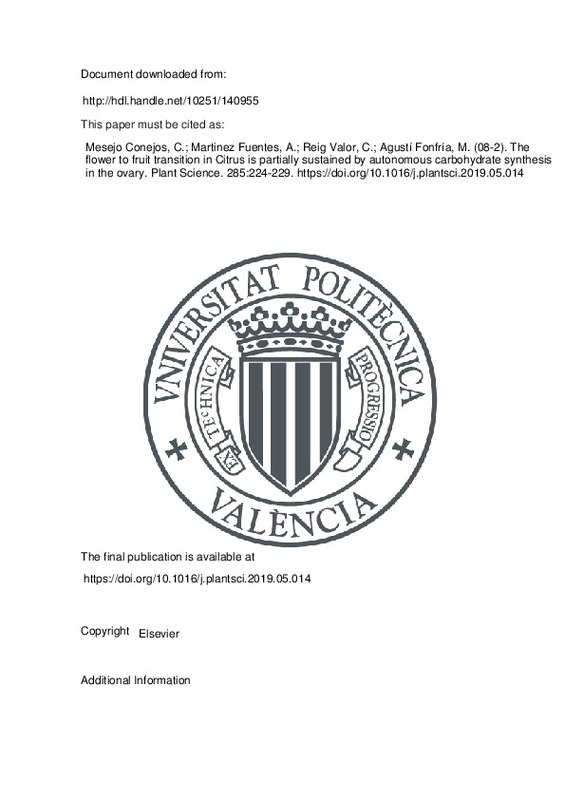JavaScript is disabled for your browser. Some features of this site may not work without it.
Buscar en RiuNet
Listar
Mi cuenta
Estadísticas
Ayuda RiuNet
Admin. UPV
The flower to fruit transition in Citrus is partially sustained by autonomous carbohydrate synthesis in the ovary
Mostrar el registro sencillo del ítem
Ficheros en el ítem
| dc.contributor.author | Mesejo Conejos, Carlos
|
es_ES |
| dc.contributor.author | Martinez Fuentes, Amparo
|
es_ES |
| dc.contributor.author | Reig Valor, Carmina
|
es_ES |
| dc.contributor.author | Agustí Fonfría, Manuel
|
es_ES |
| dc.date.accessioned | 2020-04-17T12:51:36Z | |
| dc.date.available | 2020-04-17T12:51:36Z | |
| dc.date.issued | 2019-08 | es_ES |
| dc.identifier.issn | 0168-9452 | es_ES |
| dc.identifier.uri | http://hdl.handle.net/10251/140955 | |
| dc.description.abstract | [EN] Why evergreen fruit tree species accumulate starch in the ovary during flower bud differentiation in spring, as deciduous species do during flower bud dormancy, is not fully understood. This is because in evergreen species carbon supply is assured by leaves during flower development. We suggest the existence of an autonomous mechanism in the flowers which counteracts the competition for photoassimilates with new leaves, until they become source organs. Our hypothesis is that starch accumulated during Citrus ovary ontogeny originates from 1) its own photosynthetic capacity and 2) the mobilization of reserves. Through defoliation experiments, we found that ovaries accumulate starch during flower ontogeny using a dual mechanism: 1) the autotrophic route of source organs activating Rubisco (RbcS) genes expression, and 2) the heterotrophic route of sink organs that hydrolyze sucrose in the cytosol. Defoliation 40 days before anthesis did not significantly reduce ovary growth, flower abscission or starch concentration up to 20 days after anthesis (i.e. 60 days later). Control flowers activated the energy depletion signaling system (i.e. SnRK1) and RbcS gene expression around athesis. Defoliation accelerated and boosted both activities, increasing SPS gene expression (sucrose synthesis), and SUS1, SUS3 and cwINV (sucrose hydrolysis) to maintain a glucose threshold which satisfied its need to avoid abscission. | es_ES |
| dc.language | Inglés | es_ES |
| dc.publisher | Elsevier | es_ES |
| dc.relation.ispartof | Plant Science | es_ES |
| dc.rights | Reserva de todos los derechos | es_ES |
| dc.subject | Citrus | es_ES |
| dc.subject | Parthenocarpy | es_ES |
| dc.subject | Starch | es_ES |
| dc.subject | Sucrose | es_ES |
| dc.subject | Rubisco | es_ES |
| dc.subject | SnRK1 | es_ES |
| dc.subject.classification | PRODUCCION VEGETAL | es_ES |
| dc.title | The flower to fruit transition in Citrus is partially sustained by autonomous carbohydrate synthesis in the ovary | es_ES |
| dc.type | Artículo | es_ES |
| dc.identifier.doi | 10.1016/j.plantsci.2019.05.014 | es_ES |
| dc.rights.accessRights | Abierto | es_ES |
| dc.contributor.affiliation | Universitat Politècnica de València. Departamento de Producción Vegetal - Departament de Producció Vegetal | es_ES |
| dc.description.bibliographicCitation | Mesejo Conejos, C.; Martinez Fuentes, A.; Reig Valor, C.; Agustí Fonfría, M. (2019). The flower to fruit transition in Citrus is partially sustained by autonomous carbohydrate synthesis in the ovary. Plant Science. 285:224-229. https://doi.org/10.1016/j.plantsci.2019.05.014 | es_ES |
| dc.description.accrualMethod | S | es_ES |
| dc.relation.publisherversion | https://doi.org/10.1016/j.plantsci.2019.05.014 | es_ES |
| dc.description.upvformatpinicio | 224 | es_ES |
| dc.description.upvformatpfin | 229 | es_ES |
| dc.type.version | info:eu-repo/semantics/publishedVersion | es_ES |
| dc.description.volume | 285 | es_ES |
| dc.relation.pasarela | S\389613 | es_ES |







![[Cerrado]](/themes/UPV/images/candado.png)

